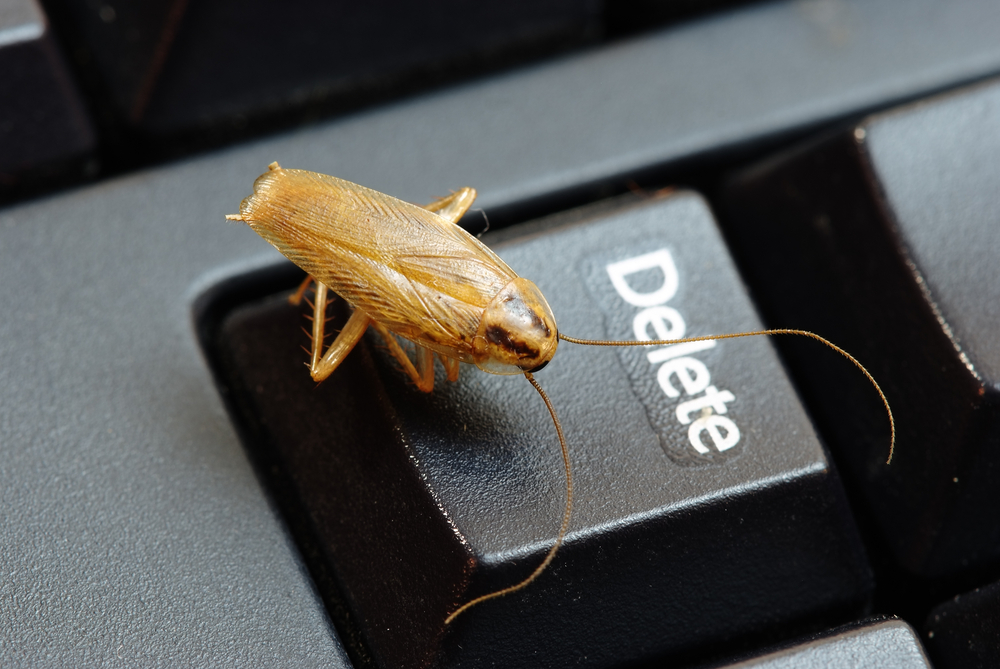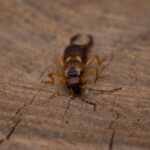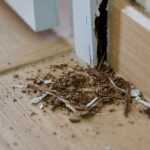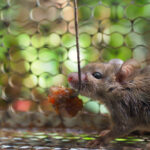How to Identify and Eliminate German Cockroach Infestations
Seeing small, tan cockroaches around the house? You might have a German cockroach problem. These pests are fast breeders and can pose health risks. This article will help you identify them, understand their behavior, and get rid of them effectively.
- German cockroaches are identifiable by their size, color, and distinctive dark stripes, with effective control hinging on accurate identification.
- Understanding the life cycle of German cockroaches—egg, nymph, and adult—is crucial for timely intervention, as a single female can produce up to 350 offspring.
- Preventative measures, including effective sanitation, sealing entry points, and moisture control, are essential in mitigating the risk of German cockroach infestations.
Identifying German Cockroaches
Recognizing German cockroaches is the first step in controlling their population. These pesky insects typically measure between ½” to 5/8” in length and have a distinctive light brown to tan color, making them relatively easy to spot once you know what to look for. However, their small size allows them to hide in the narrowest of spaces, often going unnoticed until the infestation becomes severe.
Adult German cockroaches possess two pairs of wings, with the outer pair acting as a protective shield. Males are slender and tapered, while female German cockroaches are wider and more rounded. One of the most distinctive features of German cockroaches is the two dark parallel stripes that run from their head to the base of their wings. These stripes are a key identifier that sets them apart from other cockroaches.
The young ones, known as german cockroach nymphs, initially appear white but quickly turn dark brown after hatching. Differentiating German cockroaches from similar species like the Asian cockroach, which can sometimes be confused due to their similar size and color, is crucial. Recognizing these specific traits allows for accurate identification and effective steps towards controlling German cockroach infestations.
German Cockroach Life Cycle
Effective pest control hinges on understanding the life cycle of German cockroaches. These insects undergo three main stages: egg, nymph, and adult. With a life cycle that can complete in around 100 days under favorable conditions, rapid action is necessary once an infestation is suspected.
The typical egg case, or ootheca, of a German cockroach is a small, brown capsule that contains approximately 30 to 40 eggs. Remarkably, a single adult female German cockroach can produce around 350 offspring throughout her life. This prolific breeding is a significant factor in the rapid growth of cockroach populations, especially among adult females.
Once the eggs hatch, the nymphs emerge and begin their development. These nymphs are dark brown to black and lack wings, molting five to six times before reaching adulthood. The nymphal stage lasts about 60 days at room temperature, after which they become adults capable of reproducing. Adult German cockroaches typically live for five to seven months, during which time they continue to contribute to the infestation.
Why German Cockroaches Infest Homes
German cockroaches find human homes particularly attractive due to the abundance of warmth, food, and moisture. These cockroaches thrive in warm, humid environments, making kitchens and bathrooms their favorite places to infest. Their small size allows them to hide in narrow spaces, making it easy for them to establish and grow their populations unnoticed.
Common places to find German cockroaches include around appliances, under sinks, and in pantries. They are especially drawn to food particles, spilled liquids, and even dead skin, which are plentiful in kitchen and bathroom areas. These readily available food sources make homes an ideal environment for these pests.
Moreover, German cockroaches are nocturnal, which means they are active at night and often go unnoticed during the day. This nocturnal behavior, combined with their ability to hide in tiny cracks and crevices, makes it difficult to detect an infestation until it becomes severe. Understanding these habits is crucial for effectively controlling German cockroach infestations.
Health Risks of German Cockroaches
German cockroaches are not just a nuisance; they pose significant health risks. These pests can contaminate food and kitchen surfaces with bacteria and viruses, leading to foodborne illnesses. They can spread pathogens like Salmonella and E. coli, which can cause severe gastrointestinal issues.
Additionally, German cockroach feces and shed skins contain allergens that can trigger severe allergic reactions and asthma in sensitive individuals. Prolonged exposure to these allergens can lead to chronic conditions such as dermatitis and persistent itching.
Due to these health risks, immediate action to eradicate German cockroaches upon detection is necessary.
Preventing German Cockroach Infestations
Maintaining a healthy home environment requires preventing German cockroach infestations and ensuring german cockroach survival. The key lies in effective sanitation, sealing entry points, and reducing moisture. A thorough cleaning routine can significantly deter these pests by eliminating accessible food sources and keeping potential harborage areas clean.
Consistent cleaning of kitchen and bathroom areas, coupled with proper food waste disposal, can make your home less appealing to German cockroaches. Additionally, sealing cracks and crevices around your home can prevent these pests from finding entry points and establishing infestations.
Addressing moisture issues by repairing leaky pipes and ensuring proper ventilation can further reduce infestation risks.
Sanitation Practices
Sanitation is a critical aspect of preventing German cockroach infestations. Cockroaches are highly attracted to food remnants, so immediate cleanup after meals is vital. Regular vacuuming can also help clear out crumbs and potential cockroach eggs from various surfaces, reducing the chances of an infestation.
Proper disposal of leftover food in sealed containers or bins is another important step in sanitation. This practice prevents cockroaches from accessing food sources and helps maintain a clean environment that is less inviting to these pests.
Sealing Entry Points
Sealing entry points effectively prevents German cockroaches from infesting your home, as they are attracted to food, water, and warmth commonly found in kitchens and bathrooms.
Sealing cracks and crevices around pipes, under doors, and other potential entry points significantly reduces the likelihood of a German cockroach infestation.
Reducing Moisture
Lowering moisture levels in your home is another crucial step in preventing German cockroach infestations. Excessive moisture and leftover food material can attract these pests, especially in the kitchen and bathroom areas. Regularly checking for and fixing leaky pipes can help manage moisture levels and make your home less hospitable to cockroaches.
Managing German cockroaches effectively requires combining several strategies, including addressing moisture sources. Integrated pest management (IPM) emphasizes combining monitoring, sanitation, and targeted chemical use for comprehensive cockroach control.
Effective Control Methods for German Cockroaches
Controlling German cockroaches effectively requires an integrated approach that combines various methods. Sanitation alone is insufficient; it must be paired with other control strategies to ensure comprehensive management of infestations.
This comprehensive approach targets all stages of the German cockroach life cycle, reducing their populations through effective german cockroach control.
Sticky Traps
Sticky traps effectively detect and monitor cockroach populations. These traps can capture cockroaches, allowing you to assess the level of infestation and identify the areas where they are most active.
Strategically placing sticky traps around your home provides valuable insights into the infestation’s extent, allowing for targeted action.
Chemical Control
Chemical control options, such as insect growth regulators and bait formulations, are essential components of effective cockroach control. Insect growth regulators disrupt young cockroaches’ development, gradually reducing their population.
Bait formulations are particularly effective for their long-lasting effects and ability to target hidden cockroaches.
Integrated Pest Management
Integrated pest management (IPM) is the most comprehensive approach to controlling German cockroach infestations. IPM combines sticky traps, sanitation, chemical control, and follow-up inspections to ensure effective and sustainable cockroach management.
Sealing cracks and crevices and conducting regular follow-up inspections help prevent future infestations and maintain a cockroach harborages-free environment.
Professional Pest Control Services
When dealing with a severe German cockroach infestation, professional pest control services can provide the expertise and resources needed to eradicate these pests. Gopher Patrol offers comprehensive pest control solutions tailored to eliminate German cockroach infestations. They utilize environmentally responsible methods, such as low-impact gel baiting, to manage pest issues effectively and sustainably.
Upon encountering a German cockroach infestation, contacting a licensed pest control professional is advisable. Gopher Patrol’s experienced technicians can assess the situation, implement effective control measures, and provide ongoing monitoring to ensure your home remains pest-free.
Understanding how to identify, prevent, and control German cockroach infestations is crucial for maintaining a healthy home environment. By implementing effective sanitation practices, sealing entry points, reducing moisture, and utilizing integrated pest management strategies, you can keep these pests at bay. If you encounter a severe infestation, don’t hesitate to contact Gopher Patrol for professional pest control services. Your home deserves to be a safe and healthy place, free from the threats posed by German cockroaches.
Frequently Asked Questions
Where do German cockroaches lay eggs?
German cockroaches typically lay their eggs in tight crevices, favoring dark, warm, and humid areas like bathroom sinks and kitchen cabinets. To effectively control their population, it’s essential to target these environments.
How do you get rid of German cockroaches?
To effectively eliminate German cockroaches, use a high-quality roach bait like Invict Gold along with an insect growth regulator (IGR) like Tekko IGRs, which can prevent their reproduction. This combined approach ensures both immediate extermination and long-term control.
Why am I seeing German cockroaches?
You’re seeing German cockroaches because they are attracted to warm, humid environments near food and water sources, often entering your home through items like grocery bags or secondhand goods. Eliminating clutter and sealing entry points can help keep them out.
Are German roaches the hardest to get rid of?
Yes, German cockroaches are among the hardest pests to eliminate due to their rapid reproduction and resilience, often necessitating professional intervention for effective control.
How can I identify a German cockroach infestation?
To identify a German cockroach infestation, observe for small, light brown to tan cockroaches with two dark parallel stripes on their thorax, particularly in kitchens and bathrooms. Prompt action is recommended if these signs are noticed.





